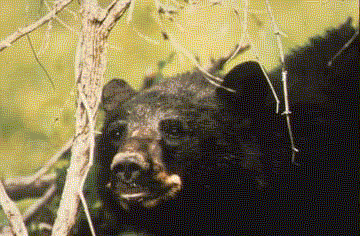Louisiana Black Bear

FAMILY:
Ursidae
STATUS:
Threatened, Federal Register, January 7, 1992
DESCRIPTION:
The Louisiana black bear is one of sixteen recognized subspecies of the American black bear U. americanus (Hall, 1981). This species was formerly widespread in North America, from northern Alaska, including Newfoundland, south to central northern Mexico (Lowrey, 1981). The Louisiana black bear is distinguished from other black bears by possessing a skull that is longer, more narrow, and flat, and by possessing proportionately large molar teeth (Nowak, 1986). Black bears are huge, bulky mammals with long black hair. Although weight varies considerably, large males may weigh more than 6OO pounds.
BIOLOGICAL INFORMATION:
The Louisiana black bear is a habitat generalist and often overwinters in hollow cypress trees either in or along sloughs, lakes, or riverbanks in bottomland habitats of the Tensas and Atchafalaya river basins. These bears are mobile, opportunistic, largely herbivorous omnivores that exploit a variety of foods and closely track phenological development. The distribution and abundance of foods, particularly mast, largely affects their movements. The size of an individual's range or area it traverses annually to secure food and mates and to care for young, is probably directly related to the diversity of vegetative cover, or habitats. Constituent elements of black bear habitat include hard and soft mast, escape cover, denning sites, corridor habitats, and some freedom from disturbance by man.
REPRODUCTION AND DEVELOPMENT:
While some females may breed at 3 years of age, it is likely that most don't breed until 4 years of age (Smith, 1983). Based on testicular measurements (Smith, 1983), males probably reach sexual maturity at 3 years of age. Females of breeding age in the nearby St. Francis River bottoms of Arkansas had a mean breeding interval of 2.5 years (Smith, 1983). Parturition in black bears has generally been assumed to occur in late January or early February with the actual birthing often occurring while the female is in hibernation. Litter size ranges from one to three.
HABITAT:
The black bear was considered numerous at the time of early colonization, serving as food both for Indians and white settlers (Lowrey, 1981). White man's occupation of the land, hunting, and ultimately habitat destruction through conversion of the virgin forests for farming combined to bring about the decline of the Louisiana black bear. The Louisiana black bear is now restricted primarily to the Tensas and Atchafalaya River Basins in Louisiana. These bears make long range movements and not uncommonly occur in adjacent Mississippi. However, it is unknown whether breeding numbers exist outside of Louisiana. The Louisiana black bear's occupied habitat consists primarily of bottomland hardwood timber found in its river basin habitats.
MANAGEMENT AND PROTECTION:
Black bears are featured as priority species for protection and management on the Tensas and Atchafalaya River National Wildlife Refuges, State-owned lands, and on certain important privately-owned tracts, such as Deltic Farms near Tallulah, Louisiana. Additionally, important research on basic life history questions is occurring on the Tensas River National Wildlife Refuge and in the lower Atchafalaya River basin. The Louisiana black bear's threatened status warrants protection under sections 7 and 9 of the Endangered Species Act. The State of Louisiana has increased fines for illegal killing of bears. The Black Bear Conservation Committee (BBCC), a coalition of private and public interests formed to insure the necessary private landowner cooperation to restore the bear, promotes numerous private and public initiatives to insure conservation of this species.

